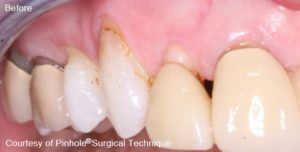Stop “Watching” Gum Recession!
May 9, 2017
Please stop me if you’ve seen this story unfold before. Your patient comes in for a cleaning and exam. Their teeth are sensitive, so your hygienist

Don’t “Watch” This
takes special care to avoid the exposed root around #’s 19 and 20. Recession.
Last year, you prescribed fluoride trays to help relieve the sensitivity. You don’t know if they are using the trays, however, because you can’t recall the last time you authorized a refill on the gel.
The exposed root causes the patient to jump out of the chair at the slightest contact with room temperature irrigation water or (gasp!) the scaler. You come in for your exam and note gum recession, which has deepened by .5mm since last year. There’s no active periodontal disease or infection, the recession seems to be caused by parafunctional habits. You consider prescribing a nightguard.
“Let’s keep watching this area on the lower left here. You have a little bit of gum recession going on there. That’s why those teeth are so sensitive”.
The Gum Recession is Not Going to Improve- It’s Going to Get Worse
“Let’s keep watching this area on the lower left here. You have a little bit of gum recession going on there. That’s why those teeth are so sensitive”. You’ve been watching the recession for 2 years, but the gum tissue is never going to grow back. Your hygienist, kind as she is, laments having to be so careful around those teeth, which could really use some scaling, but your poor patient deals with pain and sensitivity on a daily basis.
Why do you continue to “watch” this area? Would you “watch” the area if it was a small occlusal decay?
50% of Your Patients Will Develop Some Form of Gum Disease
It’s no exaggeration that about half of all your patients have or will have some form of gum disease, and that figure jumps to 70% for patients over age 65. Are you “watching” gum recession in 50% of your patients, waiting for it to progress to a serious problem? What about 25% of your patients?
Early intervention is the key to preventing tooth loss from recession. As time marches on, the alveolar bone continues to deteriorate, bringing the gum tissue down with it. Not only can correction of recession provide an aesthetic improvement, but it can also prevent further bone loss and eventual tooth loss.
Combined with correcting the cause of the recession, state of the art techniques, such as the Chao Pinhole Surgical Technique are minimally invasive with no downtime. This treatment provides dramatic results that can help your patients keep their natural teeth longer, relieve sensitivity from exposed root surface, and improve appearance. For more advanced bone loss, grafting and regeneration of alveolar tissues may help reverse the damaging effects.
Chao Pinhole Surgical Technique

Pinhole Technique Corrects Gum Recession Without Down Time
Treating recession before it becomes a serious problem is key to maintaining strong, healthy teeth for a lifetime. Give Dr. Q a call, and let’s schedule a Lunch & Learn to provide you and your team with important tools to help do the right thing for more patients with recession.
No Comments »
No comments yet.
RSS feed for comments on this post. TrackBack URL
